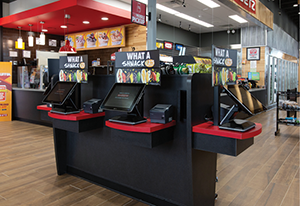 In the Mid-Atlantic, kiosks to select MTO food have long been a feature at Sheetz
In the Mid-Atlantic, kiosks to select MTO food have long been a feature at Sheetz
Walk into a growing number of quick-service restaurants and convenience stores and you’ll have several options to place your food order—at a kiosk, at a counter or via a mobile app.
“Convenience stores are going through a transition period,” said Brandon Barton, CEO of Bite, which provides the technology for in-store kiosk ordering. “Some of these retailers understand that consumers have gone through a mass adoption of online ordering, and that spills over into mobile and kiosk foodservice ordering from a convenience store.”
While c-store chains with fresh foodservice like Sheetz, Casey’s, Kum & Go and Wawa have jumped on mobile app and in-store kiosk ordering, implementation by the industry as a whole has a ways to go. “The next phase of digital adoption is happening in c-stores right now,” Barton said. “As more people travel and stop at gas stations and convenience stores, these retailers will need digital strategies to meet the growing need for fast, fresh food, especially as labor continues to be a challenge.”
We view digital ordering as both our present and future as we serve our customer.”
THE LANDSCAPE
Digital orders have jumped to a third of total convenience store and restaurant food orders, according to a May 2022 Paytronix Systems Inc. survey. While in-store sales remain down by nearly half, digital orders have stayed elevated at 113% of pre-pandemic levels.
“It’s great for a customer to order a sandwich online once, but keeping that customer coming back and extending their lifetime value is where the benefit of a customer engagement platform truly lies,” said Andrew Robbins, CEO of Paytronix. “The pandemic forever shifted the landscape, and today brands need to focus themselves on how to manage the full digital customer engagement ecosystem. Digital ordering is clearly a must-have for anyone doing food ordering, and it’s emerging quickly for center-store items. But taking things one step further, each interaction creates data that teaches a brand more about its customers. This means digital ordering cannot stand alone, but needs to work perfectly with loyalty, CRM, messaging and other technologies.”
This underscores the need for food-forward convenience retailers to utilize digital ordering to serve more customers while freeing up staff to make the food and provide other services. While delivery was king before and during the height of the pandemic, data indicate takeout orders now dominate digital orders, with numbers soaring above pre-pandemic levels. For example, carryout food orders skyrocketed from around 35% in January 2020 to 55% in March 2022, according to the Paytronix study.
For Barton, the concept of digital ordering has become more familiar with more consumers. “Because of how much online and mobile app ordering we did during the pandemic lockdowns, the average consumer is well aware of how to key in their orders,” he said. “Thus, when retailers create an environment without lines with self-serve ordering kiosks, consumers are more eager and able to place their food orders there.”
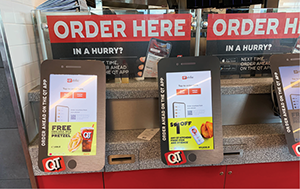 Customers at this QuikTrip in Texas can easily order freshly prepared food via kiosk or mobile app
Customers at this QuikTrip in Texas can easily order freshly prepared food via kiosk or mobile app
THE DIGITAL SOLUTION
Convenience stores with fresh foodservice know one of their major advantages is serving customers quickly and efficiently. Mobile apps and kiosks help by providing several ways for customers to place orders. But before diving into digital ordering, retailers should consider how the technology will impact their current operations.
“Sometimes as retailers, we don’t think about how we can use the technology to improve operations, improve the store, improve the flow of products or improve the supply chain,” said Amir Hassan, director of retail and operations for H&S Energy during the “From Corner Store to Digital Store” education session at the 2022 NACS Show.
Having multiple kiosks for ordering gives the perception of fast service, and thus the retailer is less likely to lose business.”
Hassan recommended thinking about how your customers will interact with digital ordering before investing in it. “Do you think they will adopt this technology? Often, it depends on where you are [geographically],” he said. “Also, make sure your employees will be able to meet the demand [of more food orders] ... at all times of the day.”
For Kum & Go, getting into digital ordering two years ago made sense because it would “make the days of our customers and employees better,” said Levon Hooks, chief information officer for the 400-plus-unit chain based in Des Moines, Iowa. “We view digital ordering as both our present and future as we serve our customer.”
Kum & Go tapped Bite as its partner for in-store kiosks. The retailer based the kiosk order experience on its mobile app ordering process. “We wanted to integrate ordering food across all systems and also provide an easy way for our customers to place in-store orders,” Hooks said.
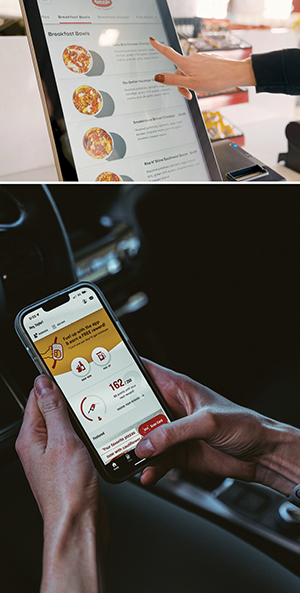 Kum & Go rolled out its new made-fresh-for-you menu in 2022 and added new mobile ordering capabilities.
Kum & Go rolled out its new made-fresh-for-you menu in 2022 and added new mobile ordering capabilities.
The company conducted market research with Kum & Go’s customer base prior to launching into digital ordering to confirm most guests were ready and willing to place digital orders. “It’s been a tremendous success, with our customers adapting to kiosk and mobile app ordering, as well as self-checkout,” Hooks said. “We’ve had great feedback from customers about the process.”
THE TECHNOLOGY
Adding ordering kiosks to a foodservice program can be fairly simple, especially when partnering with a third-party provider like Bite. “While some of the larger national brands have developed their own proprietary technology for mobile apps and kiosks, companies like Bite offer retailers the option of utilizing what we’ve built and integrating that into their operations without having to start from scratch,” Barton said. “This means a single operator to a thousand-store chain can have access to the same technology.”
Barton pointed out that “independent operators and chains with foodservice will lose customers who don’t want to wait in a line to place an order. Having multiple kiosks for ordering gives the perception of fast service, and thus the retailer is less likely to lose business.” Just having an ordering kiosk doesn’t guarantee sales. Bite works with retailers on adding mounted wall screens and marketing signage to let guests know the kiosks are ready to take their order. “We also help them decide how many kiosks they should have based on sales volumes,” Barton said.
Kum & Go started with two kiosks per store but built in flexibility to add more as sales increased. “We only use the kiosks for our made-to-order menu and have been pleased with the speed and efficiency of the ordering process for our customers,” Hooks said. By offloading the ordering to technology, Kum & Go has been able to focus more on providing excellent service and food. The operations team maps out how many employees are needed for each store to handle the influx of orders both from kiosks and its mobile app.
Having multiple kiosks for ordering gives the perception of fast service, and thus the retailer is less likely to lose business."
For retailers considering working with a tech partner for digital ordering, Hooks suggested making sure the third-party company offers flexibility and collaboration. “We knew going into our partnership with Bite we would have changes, and we wanted to be sure we had room to expand and grow,” he said. For example, during the first quarter of 2023, all Kum & Go kiosks added a Spanish-language option for ordering.
Having digital ordering options also tees up a retailer to add delivery more easily. “People are more interested in delivery these days, so retailers who are already familiar with digital orders, whether through kiosks or mobile apps, can pivot more quickly to delivery,” Barton said.
Hooks indicated Kum & Go is considering third-party delivery as a natural next step. “Now that we’ve seen how well the kiosks and mobile ordering has gone, delivery is on our radar and we hope to have something for our customer base soon,” he said. “For example, with pizza continuing to be a strong item from our mobile app ordering perspective, we’re in a good position to offer delivery, too.”
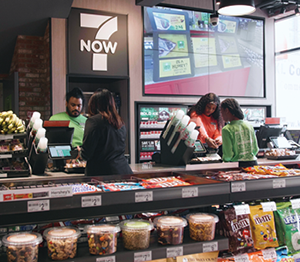 Customers craving Laredo Taco food at some 7-Eleven Evolution Stores can order via a kiosk in the food-service area and then use self-checkout
Customers craving Laredo Taco food at some 7-Eleven Evolution Stores can order via a kiosk in the food-service area and then use self-checkout
Bite’s Barton emphasized how digital ordering can expand beyond the kiosk to include a mobile app as well as ordering at the pump. “Convenience stores have opened what are essentially restaurants inside their stores, and kiosks help draw the attention of customers to that fact,” he said. “Our research shows kiosks reduce labor costs and increase check sizes, thus helping to ease labor issues and boosting a retailer’s bottom line at the same time.”
The Personal Touch
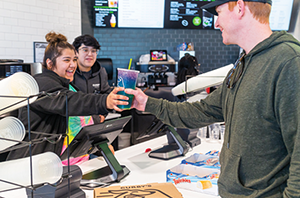
Not every retailer sees digital ordering as good for their business. For example, Curby’s Express Market in Lubbock, Texas, decided not to install ordering kiosks for its fresh foodservice, even though it does have two self-checkout stations. “We wanted our customers to have more interaction with the staff, to engage with our staff and vice versa,” said Tony Sparks, head of customer wow! for the burgeoning chain.
His reasoning was simple—the importance of the personal encounter with a staff member in turning a casual shopper into a frequent one. “Whether at our drive-thru or inside the store, customers have to place their foodservice order with a live person. By providing them an order barcode ticket for self-checkout, they’re free to conduct the rest of their in-store trip without engaging with anyone else,” he said.